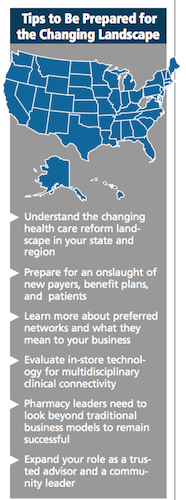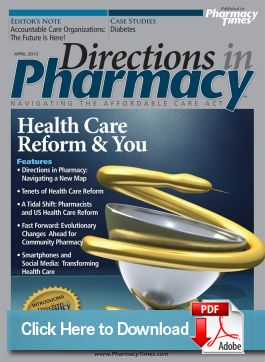Publication
Article
Pharmacy Practice in Focus: Oncology
Fast Forward: Evolutionary Changes Ahead for Community Pharmacy
Author(s):
The growing trend of accountable care organizations gives pharmacists the chance to make a greater impact on the health of their patients in a team approach that saves both dollars and lives.

The growing trend of accountable care organizations gives pharmacists the chance to make a greater impact on the health of their patients in a team approach that saves both dollars and lives.
In recent years, the practice of pharmacy has come back to its roots of individualized and personal prescription care. But in upcoming years, the evolution of the pharmacy industry will likely take giant leaps and lurches.
Service lines of the traditional community pharmacy, health-system pharmacy, and large chain pharmacy—will begin to blur. The rate of evolution will also escalate in 2013 and beyond while health care reform continues, driven primarily by continued implementation of provisions of the Affordable Care Act (ACA).
As health care reform unfolds on both the national and state fronts, the marketplace will transform into a landscape unlike anything previously seen within our industry. It will bring great opportunity for pharmacies, but will also bring its share of challenges.
The Congressional Budget Office projects that 32 million more people will have health coverage by 2019. This will mean an influx of new pharmacy patients or existing patients who gain coverage. However, state-by-state implementation of Medicaid expansion and public health care exchanges will create a complex patchwork that will yield a proliferation of state-based and regional payers and new prescription plans. And while this state-based patchwork may be well suited to small chains and independent pharmacies, it will be a serious challenge for many large regional and national pharmacy companies to manage.
Under these new benefit plans, pharmacies will likely see more narrowed networks and similar, or potentially even lower, blended reimbursement rates. However, there may be some new and expanding opportunities to gain revenue through professional service fees. Overall, pharmacies can expect more patients and thus more gross revenue, but it is anticipated that reimbursement rates will put more downward pressure on margins.

With the projected increase in the number and types of pharmacy benefits being offered, participation in preferred networks is a must for long-term sustainability. These narrowed networks are a great opportunity for pharmacies to retain patients, and even gain new patients as network managers divide lives between fewer providers. In fact, the industry is already seeing evidence of a growing popularity of preferred pharmacies.
According to a study by Drug Channels Institute chief executive officer Adam J. Fein, PhD, for 2013, 44% of Medicare Part D beneficiaries chose a plan that financially rewards them for using a preferred pharmacy.
“Beneficiaries are seeing lower copays and potentially seeing lower out-of-pocket costs through preferred networks, which ultimately drive them to preferred pharmacies,” says Smart Insurance Company chief executive officer Pritpal Virdee. “Layer on top of that the fact that the mandatory main- tenance of certain drugs will continue to rise and pharmacies are sure to have a complex road to navigate due to the fast-changing health care landscape.”
Lines Are Blurring
As the industry continues to evolve, lines of distinction between many traditional sectors of pharmacy—community, managed care, health system, and chain drug pharmacies—are fast blurring. Pharmacy providers within these traditional sectors are beginning to aggressively explore opportunities to grow and excel outside their usual scope. RxAlly is a great example of a nontraditional alliance that even 5 years ago might have been unthinkable: a large chain and independent pharmacies coming together behind similar goals with 1 focus. With more than 12,000 independent pharmacies and 8000 Walgreens locations, RxAlly is the preferred net- work for the SmartD Rx Medicare Prescription Drug Plan.
In a recent presentation at the annual American Society of Health-System Pharmacists conference, presenters Anthony Zappa, PharmD, MBA, Steve Rough, MS, BSPharm, and Scott Knoer, PharmD, MS, pointed out that pharmacy leaders will need to begin looking beyond the traditional business models for their organizations to remain successful. Having the skills to provide entrepreneurial solutions will help continually improve the value the pharmacy brings to an organization.
At the same time, pharmacy benefit managers (PBMs) and mail order pharmacies are no longer alone in launching and operating care management programs with a national scope. To gain a greater share of chronic and specialty pharmacy patients, heighten the profile of their improving dedication to integrating more clinical practice, and potentially build new revenue sources, large chain pharmacies are providing bedside medication delivery programs, expanding specialty pharmacy operations, and building strong patient care management programs.
With PBMs as the largest sector in the specialty pharmacy market, and many health systems moving to out-patient pharmacy, specialty pharmacy, and even mail order to control costs, independent and community-based pharmacies must continue to compete vigorously to maintain patients and prescriptions. As competition grows, community pharmacies will need to vie for every specialty prescription.
Focus on Collaborative Care
Over time, networked pharmacies have proven their ability to help reduce over- all health care costs and decrease patient hospitalizations. Indeed, the growing popularity of accountable care organizations (ACOs) and collaborative care networks has afforded pharmacists the opportunity to make an even greater impact on positive patient outcomes through a heightened leadership role as a member of a multidisciplinary care team to further manage whole-patient care.
For example, Walgreens has developed an innovative ACO model with pharmacists serving as an integral part of patients’ care teams, and is uniquely positioned to help meet the triple aim of improving patient outcomes and satis- faction while lowering health care costs. “Walgreens pharmacists and Take Care Clinic nurse practitioners are the most accessible health care providers in thou- sands of communities nationwide,” said Jeffrey Kang, MD, Walgreens senior vice president of pharmacy, health, and wellness services. “By offering greater access to important, preventive services such as immunizations, health testing, medication therapy management, and various forms of patient counseling, among many others, our clinicians are working with hospitals, health systems, and physician groups to deliver integrated care that can benefit patients, payers, and the health care system at large.”
And the popularity of ACOs is growing. A November 2012 study by management consulting firm Oliver Wyman found that 25 to 31 million US patients currently receive their care through ACOs, including 2.4 million in Medicare ACO programs and 15 million non-Medicare patients in Medicare-oriented ACOs. Furthermore, 45% of Americans live in a locale served by at least 1 ACO. The study goes on to state that ACOs, little known only 2 years ago, are poised to offer a competitive threat to traditional fee-for-service medicine.
With these changes, it is imperative that community pharmacies position themselves as a collaborative partner. Technically, community pharmacy will be pressed to have the right platform of connectivity beyond just a clinical collaboration. Pharmacists must devise an IT systems solution that ensures a formal charting of health care information and greater connectivity with other health care providers to ensure a 1-view medical chart.
RxAlly chairman and chief executive officer Bruce T. Roberts says that another challenge facing pharmacies is measuring and demonstrating the clinical and economic value that they bring to the system—getting our system to fairly compensate them based on the value. “At RxAlly, we are leveraging our tools, resources, and analytics—and the collective commitment of our individual pharmacies—to measure performance, hold pharmacies accountable for demonstrating performance, and hold payers accountable for providing patients with access to pharmacist delivered services, shown by data to improve health and reduce overall costs,” he said.
A Trusted Advisor
While these evolutionary changes are encouraging pharmacists to practice and operate differently, fortunately, pharmacists will also have the opportunity to continue building on their role as trusted advisors. Patients will be looking for advice as they navigate the complexities of the ACA and the expansion of Medicaid, and as they wade through the intricacies of public exchanges while they choose a drug plan that helps them manage their personal prescription care. “Pharmacists have the unique opportunity to assume a much more meaningful role in people’s health care,” says Roberts. “They are among the most accessible health care providers, can enhance the patient experience, and are at a key intersection in health care to assist in coordination of care.”
A January 2013 survey commissioned by Smart Insurance Company validates that Medicare beneficiaries not only value the advice of pharmacists, they seek them out as trusted advisors, and as a result, are more loyal to those pharmacies. “The survey findings validated our brand promise as a company,” says Virdee. “But it also shows that there is an economic value for pharmacists to be advisors and a part of a preferred network. We know that counsel and partnership by pharmacists that helps beneficiaries effectively treat their health issues in an economically efficient way is appreciated by beneficiaries.”
While it is true that the community pharmacy’s role in the fast-changing health care landscape is evolving, there is reason to be optimistic. The effects of the projected new patients with health care coverage will be unprecedented— and it will offer pharmacists the opportunity to continue being patient advocates while building business at the same time.
Mr. McGuirk earned his bachelors of science in psychology, masters in education and masters in business administration with a concurrent post- graduate equivalency in public health from the University of Alabama at Birmingham. Prior to joining Smart Insurance Company, he spent 7 years with Walgreen Co in the specialty pharmacy division and managed market sales, government segment. His experience includes more than 20 years with infusion, specialty, community, and retail pharmacy companies, as well as several years in disease and condition management and medical publishing. Throughout his career, he has remained dedicated to building payer and provider initiatives that improve equal access to increasingly efficient and innovative health care and therapies through social marketing campaigns, health and wellness, preventive care/disease prevention and community-based harm reduction programs, and innovative plan design.







